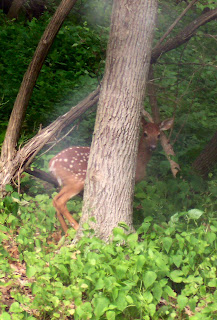Wildlife in the Garden

As the daffodil leaves push up and buds start puffing out on trees and shrubs, ground hogs and chipmunks are waking from their winter sleep and making sporadic appearances. In two more months, our perennial herd of deer will be birthing fawns, cottontails will multiply, and the flying squirrels will have moved out of our shed and into the telephone cable connector cover. The latter will be unceremoniously dumped out in what has become an annual ritual, when my phone service dies completely.
Last year, three Red Tail Hawk chicks sat in their tree-top nest a mile away for what seemed like months; then spent every summer day soaring above our house, calling out incessantly to one another, enraptured by the joy of flight. A Northern Harrier has moved in and favors a roosting tree opposite my home office window. Sometimes he’s hunting, sometimes just snoozing.
Over the winter I heard, for the first time, one of my neighbor’s many foxes “bark,” as it hunted in our wetland. After all these years living in the same place, it’s great to know that there are still new things to discover.
Our east-facing 75-foot-and-taller trees receive strong morning sun. In early spring, Turkey Vultures favor them for roosting and warming their wings. On a foggy April morning, it’s not unusual to see ten spooky shapes hunched up in a single leafless tree.
The calls of Screech Owls, the Dracula-like whoosh of the Great Horned Owl’s wings, together with Pileated Woodpecker and Yellow-Shafted Flicker cries conspire to create the illusion that a dinosaur might appear at any moment.
Just before daybreak one morning, I watched a bat laboriously wedge itself under one of the cedar shingles on the rose arbor, ignoring our carefully placed bat house nearby. I guess it couldn’t read.
Slithering ribbon and garter snakes in the flowerbeds don’t bother us; copperheads in the woodpile require caution. We know they are there, but it’s always a shock to disturb one.
This year the three male “driveway turkeys” have been displaced by twelve females. Later in the season, there will be chicks and the circus show of 20-30 heavyweight turkeys launching themselves from our plateau into the oak and hickory trees to roost for the night.
The usual songbirds at the feeder, opossum, raccoons, skunks, butterflies, dragonflies and frogs near the fountain, several kinds of bees, wasps, and beetles, salamanders, and an occasional hummingbird or black bear round out our garden guests.
While some of these critters can put a damper on our gardening efforts from time to time, we view them all as part of the great web of life on Earth. They enrich our lives immeasurably.
To read more about wildlife in the garden, join the folks over at Gardening Gone Wild http://www.gardeninggonewild.com/?p=3914#more-3914 .
Last year, three Red Tail Hawk chicks sat in their tree-top nest a mile away for what seemed like months; then spent every summer day soaring above our house, calling out incessantly to one another, enraptured by the joy of flight. A Northern Harrier has moved in and favors a roosting tree opposite my home office window. Sometimes he’s hunting, sometimes just snoozing.
Over the winter I heard, for the first time, one of my neighbor’s many foxes “bark,” as it hunted in our wetland. After all these years living in the same place, it’s great to know that there are still new things to discover.
Our east-facing 75-foot-and-taller trees receive strong morning sun. In early spring, Turkey Vultures favor them for roosting and warming their wings. On a foggy April morning, it’s not unusual to see ten spooky shapes hunched up in a single leafless tree.
The calls of Screech Owls, the Dracula-like whoosh of the Great Horned Owl’s wings, together with Pileated Woodpecker and Yellow-Shafted Flicker cries conspire to create the illusion that a dinosaur might appear at any moment.
Just before daybreak one morning, I watched a bat laboriously wedge itself under one of the cedar shingles on the rose arbor, ignoring our carefully placed bat house nearby. I guess it couldn’t read.
Slithering ribbon and garter snakes in the flowerbeds don’t bother us; copperheads in the woodpile require caution. We know they are there, but it’s always a shock to disturb one.
This year the three male “driveway turkeys” have been displaced by twelve females. Later in the season, there will be chicks and the circus show of 20-30 heavyweight turkeys launching themselves from our plateau into the oak and hickory trees to roost for the night.
The usual songbirds at the feeder, opossum, raccoons, skunks, butterflies, dragonflies and frogs near the fountain, several kinds of bees, wasps, and beetles, salamanders, and an occasional hummingbird or black bear round out our garden guests.
While some of these critters can put a damper on our gardening efforts from time to time, we view them all as part of the great web of life on Earth. They enrich our lives immeasurably.
To read more about wildlife in the garden, join the folks over at Gardening Gone Wild http://www.gardeninggonewild.com/?p=3914#more-3914 .

